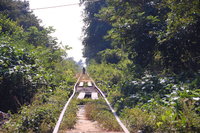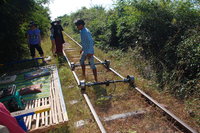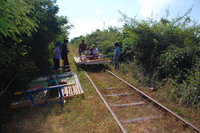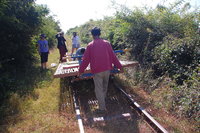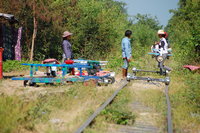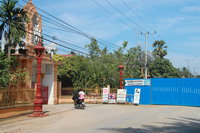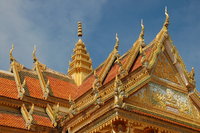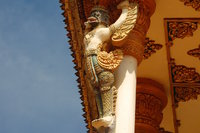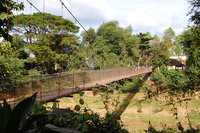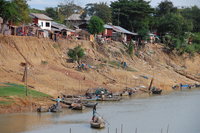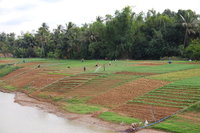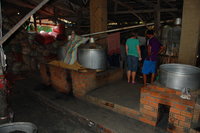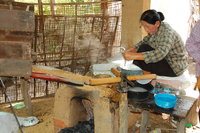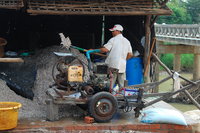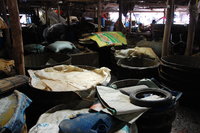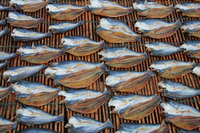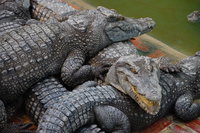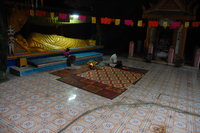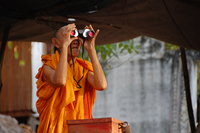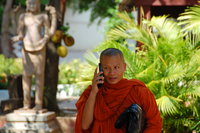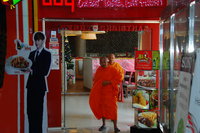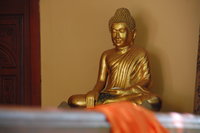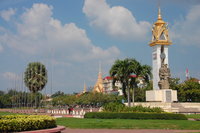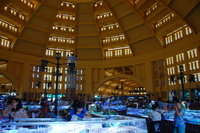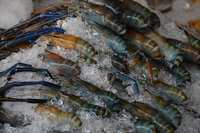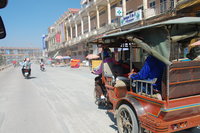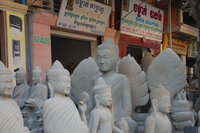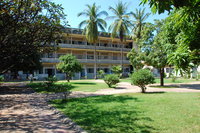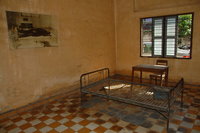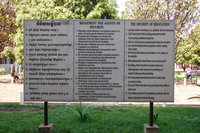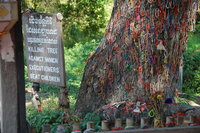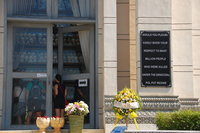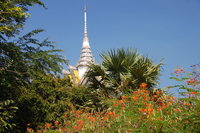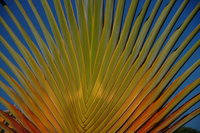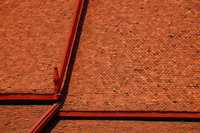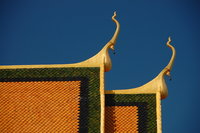The trip out of Siem Reap was our first on a Cambodian bus, so we were curious to see if they were as lackadaisical as the Vietnamese, trundling along picking up all and sundry and generally taking forever to get anywhere. Not the case! These guys like to get a shift on. Combine this urge to make progress with old bus suspension and poor quality roads and you definitely get a sense of speed! We bounced and jolted along National Highway 6 and then National Highway 5 with the horn blaring. Looking at the figures though, it seems we didn't do much above 50km/h, it just felt like it. Again, the bus sported the luxury feature of automatically reclining seats only this time, Steve's seat also reclined sideways too. This must be a super-luxury bus! Arrival at Battambang involved being dumped rather unceremoniously in a gravel area on the outskirts of town; easy prey for the waiting tuk-tuk drivers. Fortunately, as seems to be common in this part of the world, everything was good natured and, once Megan had shouted at them to shift so that we could actually get off the bus, we reached an amicable agreement with "Tony Tuk-Tuk", who drove us into town. This ferry service is a bit of a loss-leader and gives the driver time to pitch his guiding services to a captive audience.
Battambang
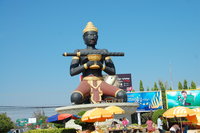
Legend says that a cow-herd called Ta Dumbong found a magical stick and used it to usurp the king. The legend goes on in a rather complicated fashion including flying white horses, invisible magicians and prodigal sons. It culminates in the cow-herd throwing the magic stick at the returning monarch and losing it. In Cambodian, Bat means lost and Tambang means stick. Welcome to Battambang.
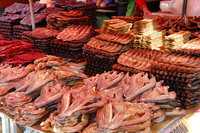
Battambang is an old French colonial town and it is likely that you can communicate with some of the older residents if you try French. It is now a provincial farming town and the surrounding area is the principal rice producer in Cambodia. The town is centered around a perpetual market by the river that really comes alive in the evenings (making insect repellent a must). There are cheap restaurants here and even cheaper stalls selling things you can eat (depending on your point of view). We examined the stuff on offer and, discovering that the market traders don't speak English, concluded that the safest things we could find that might be edible were the ones that had claws on the end - we figured this probably indicated a leg of some kind. We were very much reminded of Iquitos on the banks of the Amazon.
In the last entry, we rather glibly stated that the street naming scheme in Cambodia would be improved if contiguous numbers were used. Battambang disproves this. We found a nice café on 1½ Street and 2.5 Street contains a developing arts scene. Perhaps we should revise our comment to say that they should decide on either fractions or decimals.
Also in the last entry we said there was no railway in Cambodia. Whilst this is generally true, a surprising amount of this entry is about that very thing.
There used to be a railway from Phnom Penh to Battambang, but now it is derelict. The station still exists and appears to be regularly painted, but that's about it. There is some derelict rolling stock and the engine sheds now seem to be inhabited by some less affluent types. It is a curious sight to see all the infrastructure in place but having fallen out of use. It is rumoured that a line is to be rebuilt, connecting Phnom Penh to Bangkok. However, it is also rumoured that it is due to open next year and there is no way that this will be achieved if the Battambang section is anything to go by.
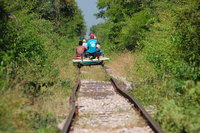
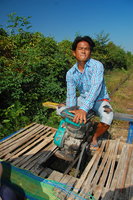
About 3km out of town, some enterprising type has commandeered a section of the now unused railway and constructed the so-called "Bamboo Train". Actually, constructed is putting it strongly, since little work or maintenance seems to have been done to the line and the "trains" consist of two pairs of wheels and a flat bamboo platform for the passengers to cling on to. This charabanc is powered by a small petrol engine that the driver holds in place. A belt transmits power to the wheels and the speed is controlled by increasing or decreasing the tension on the belt by moving the engine! The other interesting aspect is that, since the line to Battambang was only ever single-track, when these bamboo trains meet, one of them has to be dismantled and lifted off the track to allow the other to pass. Again, the word "dismantled" is probably too strong since the platform only rests on the axles. The protocol is that the train with the least number of passengers has to give way. The track is in a parlous state with consecutive rails barely aligned and, with only 20cm diameter wheels, the ride is very rough and you do need to cling on. We hurtled the 3.7km journey at what felt like break-neck speed but, rather like the bus from Siem Reap, it probably wasn't.
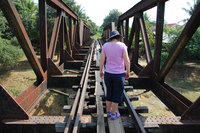
Continuing the train theme just a little longer, we [Steve] decided to walk one day to the next village to see some old wooden houses that were built in the traditional style and survived the Khmer Rouge times relatively unscathed. It is surprising how few of these there are and it is unusual to gain access. Inevitably, the walk involved trudging along a dusty road in the heat of the day. At one point we came to a section where the road was closed. In an effort to find a way round, we tried to cross an old railway bridge over the river. We only got about half way before turning back! Testament to how bad this bridge is, the locals do walk over it, but they seem to draw the line at riding motorbikes over it.
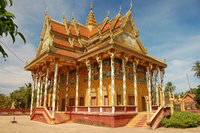
We ended up following the local traffic which had developed its own detour that involved driving through the local Wat. This was a shame in the sense that it disturbed a tranquil location with traffic, but we did get to see one of the most stunningly decorated Wats we have ever seen. Wat Kan Doeng is decorated with all manner of creatures and effigies. The lintels seem to be supported by a large number of gaudy Homer Simpsons each with a light bulb in his mouth.
We did make it to the village of WatKor and were shown around an old house by the daughter of the family who remain living there. The house has belonged to their family for generations. The most interesting aspect was that the house had been occupied by the Khmer Rouge and still bore the marks of this. We also learned that quite a number of the family were killed during this regime.
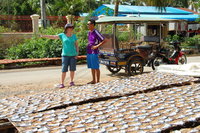
Rather uncharacteristically for us, we engaged Tony Tuk-Tuk to take us on a guided tour around some of the local attractions (usually we do this stuff by ourselves). Inevitably enough, when the nominated hour arrived, there was no sign of Tony. Apparently his tuk-tuk had "broken", which we think is Cambodian for "found a better fare". We located another chap called Han Houn to hoon around showing us the sights. Han was 17 when the Khmer Rouge rose to power and, whilst this was bad news for him, it was good news for us as we could ask him all about it. The youngsters who can speak English are not taught this history now so it's rare to find someone old enough to remember, but young enough to have learned English. The Khmer Rouge rejected learning and killed all the intellectuals in an effort to dumb down and subjugate the populous.
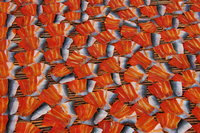
Han drove us round for two days in the end taking us to out of the way places as well as tourist attractions. He spent a lot of time explaining local customs and practices and also telling us of his experiences during the war. It became clear that he, along with pretty much everyone else had been moved out into the countryside and subject to forced labour. He described witnessing slaughter of workers and children, cannibalism and torture. They were forced to work in the rice fields day and night and fed only porridge. His parents were killed and he lost contact with his brother and sister for years, His future wife worked on the so-called killing dam which is a large local dam constructed entirely by hand in only six months. He met his wife whilst in hiding in the jungle when she tended to his malaria for three months. What can you say?
On a rather more light-hearted note, Han took us to a local crocodile farm. He stressed to us that this was a commercial enterprise only and that it didn't farm the Cambodian crocodile since it is too small. In his words, this farm housed "international standard crocodile". The beasts are reared and then sold to China, Laos and Thailand for medicine, food and handbags respectively. They are not sold domestically as they are too expensive.
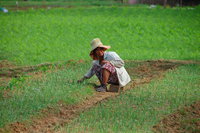
When describing the farming practices in the area and specifically seasonal variations, Han used the rather splendid word "Octember" to describe when the summer waters are at their highest. You can't fault that. We also had Han drive us out to a local mountain that is topped by a temple and which also houses the so-called Killing Cave. This is a large cave with a hole in the roof. The Khmer Rouge would throw people down this hole to get rid of them - it was cheaper than shooting them. Now there is a large reclining Buddha and a glass case full of skulls. Also in the side of the same mountain is another cave that is home to millions of bats. At dusk there is a constant stream of the things for about an hour. We had literally seconds of amusement saying to Han "to the bat cave!".
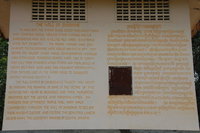
We spent quite a bit of time in the markets with Han seeing all manner of things being made and then sold including the utterly disgusting "fish paste", which contains fermented, rotting fish and has rather an unpleasant smell. In fact, fermenting things seems to be the order of the day and the rice wine, at up to 80% proof, is rather popular in town.
In the end, we judged our trips out with Han a success and we certainly learned a lot from him about what happened during the genocidal rule of the Khmer Rouge. Certainly, if half of what he said is true, then it was an utterly brutal period that should never be forgotten. When asked if he thought it could ever happen again, Han intimated that anything was possible where politicians were concerned. Plus ça change!
Phnom Penh
Imagine our surprise, on departing Battambang, to find that we were on the same bus that we had arrived on. Not only that, but Steve had the same sideways reclining seat again. This time for seven hours rather than four. What luck! Often on bus trips we observe parents stuffing their children with food to keep them quiet. It seems that Cambodians do it to themselves as well. They eat constantly and avail themselves of every rest stop to buy plastic bags containing more food. They continue pushing this stuff into their faces until the inevitable happens and the process reverses direction. This is only marginally less entertaining than the in-bus entertainment of karaoke videos and films of people hitting each other with sticks.
The journey from Battambang is along the prestigious National Highway 5 that links Bangkok with Phnom Penh and it is tarmac all the way...until you reach the outskirts of the capital at which time it degenerates into a muddy cart track for the last 20km. By the time we arrive everything is covered in a thick film of dry red dust. Except, that is, for our luggage which is covered in a thick film of wet red mud.
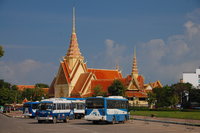
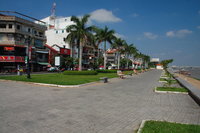
Phnom Penn is billed as everything an emerging Asian capital should be and pretty much what all the others were like 20 years ago. It is dusty, hot, noisy and chaotic with traffic and building work. High rises are starting to appear and there is no shortage of international boutiques and chains. However, even in the up-market riverside area, these shops stand shoulder to shoulder with the markets and street traders. Construction work is everywhere (including outside our bedroom window). This is surely a city on the rise. We secured some very basic accommodation for $18 per night, but it is only 25m from the riverside promenade and its expensive restaurants. A meal out for two with beer costs us $10 here!! In any other capital, this would be prime real estate, but here local market traders occupy the pavement mere yards from the Mekong and clearly many locals still live here. We wonder how long it will be before they are displaced by soaring property prices.
The capital is a rather small city and it would be possible to cover all the sights on foot were it not for the punishing heat. Shade is a prime commodity here with the forecast into the foreseeable future a steady 31°C and humid with not a breath of wind. We did do some walking (some of it was even intentional), but in the end we gave up and started using tuk-tuks. They do come with a built in breeze of course.
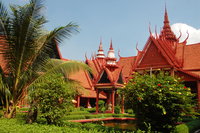
A prime attraction here is the National Museum which houses a whole bunch of statues rescued from the Angkor complexes. It is said that you should visit this place after Angkor Wat as it will make more sense, but actually it might have been better to come here first as we would then have been able to picture the sites complete with all their statues. This museum is claimed to contain the largest collection of pre-Angkorian and Angkorian carvings in the world. Of course, it probably houses the only collection, but that's a different matter. There is a whole bunch of stuff here that was not destroyed by the Khmer Rouge, but we were not allowed to photograph it; so you don't get to see it.
Our plan to visit the Royal Palace in the morning was stymied by the King who insisted on using his house for private purposes. We had to wait until the day had really heated up when he decided to open the doors at 2pm. It's a jolly fine place as you would expect. Neither of us have visited Buckingham Palace so it was a bit odd to swan in here after paying a few quid and poke around in the throne room, etc.
Of course, no visit to Phnom Penh would be complete without a visit to the killing fields. We have alluded to the Pol Pot regime a couple of times, but have not dwelt on it. There are two sites of note in the city; the Killing Fields themselves (known as Choeung Ek) and Security Prison S-21, also known as Tuol Sleng. We hired a man with a tuk-tuk for the entire day to take us to these two sites (US$15). All the information you could possibly want is available online, but a few key points bear repeating here.
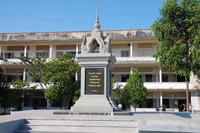
Apparently, the US dropped a very large amount of ordnance on Cambodia (who were ostensibly an ally). Irrespective of the rights or wrongs of the Vietnam war, bombing an adjacent country into the Stone Age as an expedient could hardly be described as judicious. What it did do is pave the way for Pol Pot's rise to power. After marching victoriously into Phnom Penh, the Khmer Rouge told everyone that more US bombs were coming and that they should evacuate to the countryside for three days. They were never to return. The plan was to eradicate intellectuals, artists, rich and prosperous and to reset the country back to Year Zero as they called it where everyone was a worker (except for the elite of course). Even wearing spectacles was taken as a sign of intelligence and was grounds for torture and death.
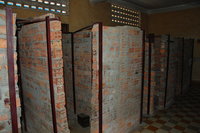
Tuol Sleng or S-21 is located in the city itself and is in a former school which makes it even more poignant. Somewhere between 12,000 and 20,000 people passed through this "facility". There are 12 confirmed survivors! This place was used to imprison and torture people, but it was never the intention to kill them here. For that, they were shipped out to Choeung Ek, the Killing Fields
Those shipped out to Choeung Ek were slaughtered in the most brutal manner and dumped into mass graves. It was a tenet of the Pot regime that bullets were too valuable to waste on the condemned. Generally, pick-axes, razor-like palm branches or hoes were used to kill people. Another tenet was that if one member of the family was condemned then they would all be killed since to remove weeds you have to remove the roots. One of the Khmer Rouge slogans was "to keep you is no gain, to kill you is no loss". And the world looked on.
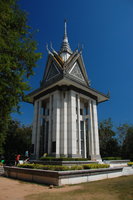
The Killing Fields site is one of around 200 that have been discovered around the country. In about three years, one in four of the entire population of the country was murdered. The Choeung Ek site is in an old orchard and today is a peaceful place that belies the fact that all this happened less than 40 years ago. We had wondered how this would compare to Auschwitz, but of course the comparison is meaningless and rather trite. What is very strange about this place is that the sky is blue, the birds are singing, butterflies flit around amongst the flowers and all is peaceful. It is hard to imagine the horror and suffering that occurred here.
Incidentally, most of what our Battambang tuk-tuk driver, Han, had told us was born out by what we learned on these visits. In particular, the perceived threat of more US bombs, evacuation to the countryside, the forced labour and the separation and subsequent loss of relatives.
One more thought before we move on, after the Khmer Rouge were ousted by the Vietnamese in 1979, they continued to be regarded as the de factor leaders and retained representation at the UN for a further 20 years! Only at this time did thoughts turn to trials for war crimes. These trials are still ongoing today despite the overwhelming evidence of guilt. As we said earlier, plus ça change!
Sorry to bring you a bit of a sobering entry in the midst of the festive season, but we were surprised at how little we knew about the whole sad affair and wanted to bring you a flavour of what we learned. Next time, normal service should be resumed. On that note, we wish you all a happy and prosperous New Year wherever you may be.
Some Pictures
